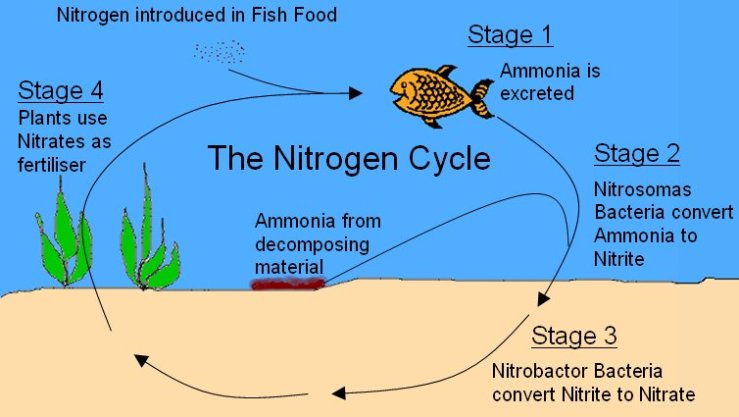Are you looking to learn more about the nitrogen cycle in your fish tank? If so, you have come to the right place. In this article, we will discuss the nitrogen cycle and how it affects the health of your fish tank. We will also discuss the importance of maintaining a healthy nitrogen cycle in order to keep your fish tank in top condition. By the end of this article, you will have a better understanding of the nitrogen cycle and its importance in keeping your fish tank healthy. So, read on to discover more about the nitrogen cycle and how it affects the health of your fish tank.
Introduction to the Nitrogen Cycle
The Nitrogen Cycle is an important process for maintaining a healthy fish tank. It is a natural process that occurs in the environment and is essential for the survival of fish. Nitrogen is a key nutrient for aquatic life, and the cycle is responsible for cycling nitrogen from the environment into the water and back out again.
The Nitrogen Cycle involves four stages. The first stage is the release of nitrogen from the environment into the water. This can come from decaying organic matter, such as fish waste, or from the atmosphere. The second stage is the conversion of nitrogen into nitrates and nitrites. This is done by beneficial bacteria in the tank. The third stage is the uptake of nitrates and nitrites by plants in the tank. Finally, the fourth stage is the release of nitrogen back into the environment. This can come from fish waste, or from the plants.
It is important to maintain a healthy Nitrogen Cycle in your fish tank, as it helps to keep the water clean and the fish healthy. Regular water changes and proper filtration are essential for keeping the cycle in balance. Additionally, adding beneficial bacteria to your tank can help to speed up the Nitrogen Cycle and keep your fish happy and healthy.
The Role of Beneficial Bacteria in the Nitrogen Cycle
Beneficial bacteria play a very important role in the nitrogen cycle in fish tanks. These bacteria convert the toxic ammonia and nitrite produced by fish waste into nitrate, which is much less harmful for fish. Without beneficial bacteria, the nitrogen cycle in a fish tank would be incomplete and the tank would become toxic for the fish.
The process of converting ammonia and nitrite into nitrate is known as nitrification and it is carried out by two types of beneficial bacteria: Nitrosomonas and Nitrobacter. Nitrosomonas bacteria convert ammonia into nitrite and Nitrobacter bacteria convert nitrite into nitrate. This process is essential in a fish tank as it helps to keep the water clean and safe for fish. The nitrate produced by the bacteria can then be removed from the tank by regular water changes.
Understanding Ammonia and Nitrite Levels in Your Fishtank
Understanding ammonia and nitrite levels in your fish tank is an important part of maintaining a healthy nitrogen cycle. Ammonia is a toxic waste product that is produced when fish excrete and when uneaten food and other organic matter decompose. Nitrite is a by-product of the ammonia-oxidizing bacteria that break down the ammonia. Both of these substances are toxic to fish, and it is important to keep their levels low.
Testing the ammonia and nitrite levels in your fish tank is the best way to ensure that the nitrogen cycle is in balance. Ammonia and nitrite test kits are widely available from pet stores in Australia, and they are relatively inexpensive. It is important to test the levels of these substances regularly, as any changes in the levels can indicate a problem in the nitrogen cycle. If the levels of ammonia and nitrite are too high, it can be an indication of overfeeding or overcrowding, and steps should be taken to rectify the issue.
Nitrate Accumulation and Its Effects on Fish Health
Nitrate accumulation is a common issue in fish tanks, and it can have serious effects on the health of the fish. Nitrate is a form of nitrogen that is produced when fish waste and uneaten food break down in the water. As nitrate accumulates, it can lead to a decrease in oxygen levels and an increase in the acidity of the water, both of which can be harmful to the fish. High nitrate levels can also cause fish to become more susceptible to disease, as their immune systems are weakened.
In order to prevent nitrate accumulation in a fish tank, it is important to regularly change the water and clean the tank. Regular water changes will help to reduce the amount of nitrate that builds up in the tank. Additionally, it is important to feed the fish only the amount that they can eat in a few minutes, as uneaten food can contribute to nitrate levels. By following these steps, fish owners can help to ensure that their fish are kept in a healthy environment.
Managing Nitrogen Levels with Water Changes and Filtration
The nitrogen cycle is essential to the health of your fishtank, and managing nitrogen levels is an important part of fishkeeping. Water changes and filtration are two of the most effective ways to manage nitrogen levels in your fishtank.
Water changes are a simple and effective way to manage nitrogen levels. Regular water changes help to remove nitrates and other toxins from the tank, reducing the amount of nitrogen in the water. This helps to keep the nitrogen cycle in balance, and prevents harmful levels of nitrogen from building up in the tank. It is important to remember to use dechlorinated water for water changes, as chlorine can be toxic to fish.
Filtration is also an effective way to manage nitrogen levels. Filtration systems help to remove nitrates and other toxins from the water, reducing the amount of nitrogen in the tank. Filtration systems come in a variety of sizes and types, so it is important to choose the right one for your tank. It is also important to regularly clean and maintain your filter, as this will help it to work more effectively and keep your tank healthy.
Common Nitrogen Cycle Problems and How to Solve Them
The nitrogen cycle is an essential part of keeping a healthy fish tank. It is the process by which nitrogen is cycled through the environment, from the water to the fish and back again. Unfortunately, there are common nitrogen cycle problems that can occur in aquariums, leading to poor water quality and unhealthy fish.
One of the most common nitrogen cycle problems is ammonia toxicity. Ammonia is produced by fish waste and uneaten food, and if it is not removed from the water, it can build up to dangerous levels. To prevent this, it is important to perform regular water changes and to make sure the filter is working properly. In addition, it is important to keep the tank clean by removing debris and uneaten food. Another common nitrogen cycle problem is nitrite toxicity. Nitrites are formed when beneficial bacteria break down ammonia, and if the levels get too high, it can be deadly to fish. To prevent this, it is important to maintain a healthy population of beneficial bacteria in the tank. This can be done by regularly performing water changes and adding bacteria supplements.
By understanding the common nitrogen cycle problems and taking steps to prevent them, aquarium owners can ensure their fish are healthy and their water quality is good. Regular maintenance and monitoring of the nitrogen cycle is essential to keeping a healthy fish tank.
Testing Your Fishtank Water for Nitrogen Levels
Testing your fishtank water for nitrogen levels is an important part of ensuring the health of your fish. Nitrogen is a key component in the nitrogen cycle, which helps to maintain a healthy and balanced environment for your fish. Testing your water for nitrogen levels allows you to identify any changes in the nitrogen cycle, which can be an indication of a problem in your fishtank.
Testing your fishtank water for nitrogen levels can be done easily and quickly with the help of a test kit. These kits are designed to detect the amount of nitrogen present in your water, and they can be purchased from most pet stores. The test kit will usually include instructions on how to use it, and the results can be compared to the recommended levels for your fish tank. If the levels are too high or too low, you can take steps to adjust the balance of nitrogen in your water. It is important to regularly test your water for nitrogen levels to ensure your fish are living in a healthy environment.
Final Thoughts
the nitrogen cycle is an important process for maintaining a healthy fish tank. It is essential for cycling nitrogen from the environment into the water and back out again. Beneficial bacteria play a key role in the nitrogen cycle, and it is important to maintain a healthy population of these bacteria in order to keep the cycle in balance. Additionally, it is important to test the ammonia and nitrite levels in your fish tank regularly, as any changes in these levels can indicate a problem with the nitrogen cycle. Finally, it is important to perform regular water changes and use a filter to manage nitrogen levels in order to keep your fish tank healthy. By understanding the nitrogen cycle and taking steps to maintain it, aquarium owners can ensure their fish are living in a healthy environment.
Nitrogen Cycle in your Fishtank FAQs
It is not recommended to add fish to your tank before the nitrogen cycle is complete, as elevated ammonia levels can be toxic to fish.
Chemical treatments like ammonia-binding compounds can help to reduce the toxicity of ammonia in your tank, but they are not a substitute for the nitrogen cycle. It is best to allow the cycle to complete naturally.
To maintain a healthy balance, you should regularly test your water quality, perform partial water changes, and avoid overfeeding your fish. Additionally, you can add live plants to your tank, which can help absorb excess nutrients.
You can test your tank’s water using a nitrate test kit. If your nitrate levels are elevated and your ammonia and nitrite levels are low, this indicates that the nitrogen cycle is complete.
You can start the nitrogen cycle by adding fish waste or other organic matter to your tank, which will encourage the growth of beneficial bacteria. Alternatively, you can use a commercial bacterial starter product to jump-start the process.
The nitrogen cycle typically takes 4-6 weeks to complete, but this can vary depending on factors like tank size, water temperature, and the amount of organic matter in the tank.
Beneficial bacteria help to break down harmful compounds in your tank and convert them into less harmful forms. They are essential to maintaining a healthy and balanced ecosystem.
Signs of an imbalance in the nitrogen cycle include elevated ammonia or nitrite levels, cloudy water, and stressed or sick fish.
The nitrogen cycle is the process by which beneficial bacteria break down fish waste and other organic matter in your fish tank, converting harmful ammonia into less harmful compounds like nitrite and nitrate.
The nitrogen cycle is crucial to maintaining a healthy and balanced ecosystem in your fish tank. Without it, ammonia levels would build up and become toxic to your fish.





